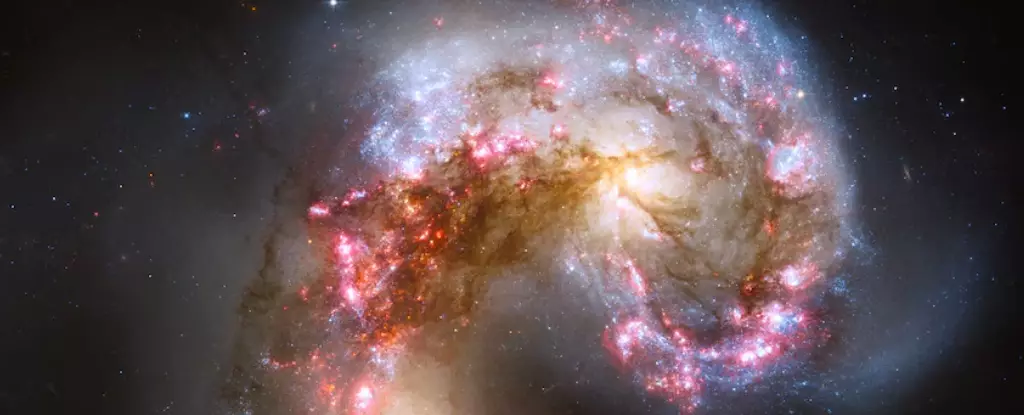The quest for understanding the cosmos is a humbling and exhilarating journey. Each discovery peels back layers of complexity surrounding the structure and evolution of the universe, revealing both its beauty and its enigmatic nature. Among the many cosmic puzzles, the formation of massive elliptical galaxies stands out as a particularly confounding enigma for astrophysicists. Recent research efforts have carved a new path into this mystery, culminating in groundbreaking observational evidence that sheds light on how these grand celestial structures came to be. Published in the prestigious journal *Nature*, these findings open new avenues for understanding celestial evolution.
Understanding Galaxy Types
In the contemporary universe, galaxies can be broadly categorized into two primary types: spiral galaxies and elliptical galaxies. Our own Milky Way exemplifies a spiral galaxy—characterized by its rotating disc rich in gas and residing comfortably alongside numerous star-forming regions. Conversely, elliptical galaxies present as enormous, spherical collections of stars that betray their ancient origins. Unlike their spiral cousins, elliptical galaxies do not engage in ongoing star formation; rather, they predominantly consist of stars formed over 10 billion years ago. The ability to explain the growth and evolution of elliptical galaxies has perplexed scientists, particularly because traditional cosmological models relied heavily on the processes observed in spiral galaxies.
The prevailing belief indicated that the origins of elliptical galaxies could be traced back to the flat, rotating discs akin to those of spiral galaxies, leading to the question: How did the flat discs morph into the three-dimensional forms we observe today?
Utilizing advanced data from the Atacama Large Millimeter/submillimeter Array (ALMA), researchers embarked on a detailed examination of the origins of these colossal elliptical galaxies. In a departure from established models, the study unearthed evidence that suggests a new paradigm: elliptical galaxies may not have formed from rotating discs at all. Instead, they likely emerged through intense, short-lived bursts of star formation during the universe’s infancy.
By scrutinizing over 100 distant galaxies—dating back to a period when the universe was merely 2.2 to 5.9 billion years old—the research team uncovered critical insights into the geometry of these primordial galaxies. Dust, a crucial marker for star formation, was found to be concentrated in compact regions rather than distributed across flat structures. This observation not only defied expectations but also indicated that early star-forming galaxies exhibited shapes more akin to present-day elliptical galaxies.
By employing novel observational techniques, researchers began to reconstruct the three-dimensional configurations of the galaxies’ dust-emitting regions. This revealed a significant deviation from the traditional view, suggesting that the early universe was populated with spherical galaxies rather than those evolving from flat discs.
To further understand the mechanisms driving the formation of these compact star-forming cores, the researchers turned to advanced cosmological simulations. Their findings unveiled how the interplay of gas streams flowing from surrounding galaxies and the violent dynamics of galaxy mergers drove gas and dust toward the centers of these embryonic galaxies. These interactions resulted in compact and densely packed regions, effectively stoking rapid star formation.
Importantly, these simulations indicate that this gas funneling phenomenon was not an isolated occurrence but rather a common process in the formative years of the universe, providing a comprehensive explanation for the swift emergence of elliptical galaxies.
A notable aspect of this research is its reliance on publicly accessible ALMA data, underscoring the importance of collaborative science. Open-access datasets allow institutions and researchers worldwide to independently verify findings, add to the knowledge pool, and accelerate discovery through shared insights. This collaborative spirit is vital for driving advancements that push the boundaries of human understanding.
Looking ahead, future research utilizing cutting-edge instruments such as the James Webb Space Telescope (JWST) and the Extremely Large Telescope (ELT) promise to refine our comprehension of star formation dynamics and gas interactions in the distant galactic progenitors. These technologies will enable a more detailed mapping of the spatial distribution of stars and the mechanics propelling gas toward centers of galaxies, ultimately illuminating the processes that have shaped the cosmos as we observe it today.
The profound implications of this research herald a new understanding of galaxy evolution while inviting ongoing exploration into the fundamental mechanisms at play in our universe, reminding us that even amidst the vastness of space, knowledge is always within reach, waiting to be uncovered.

